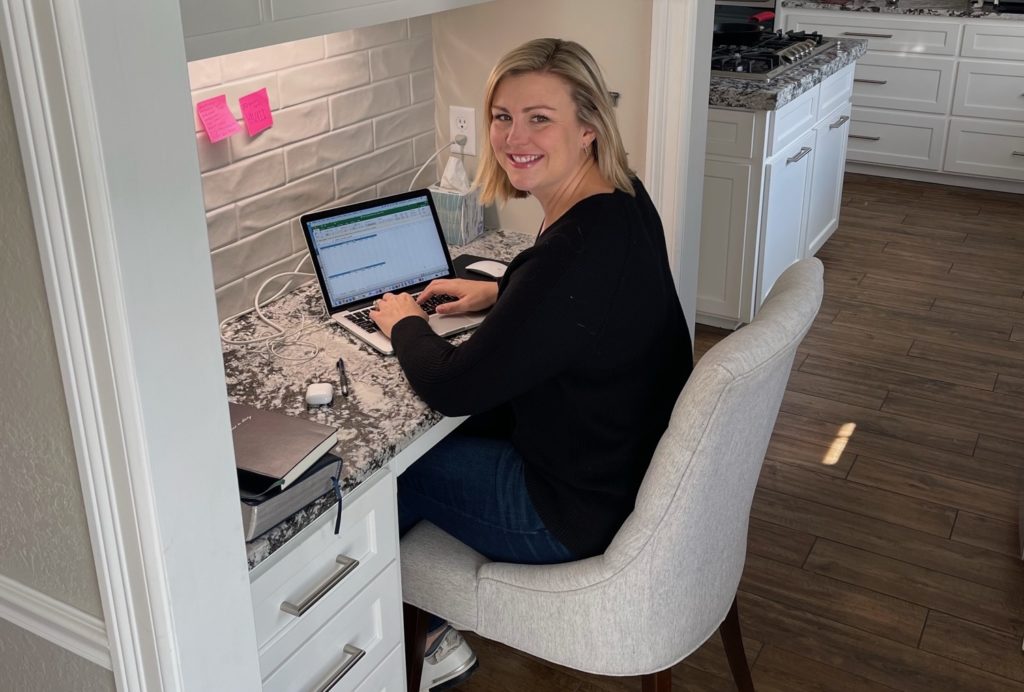An earlier version of this post was published in 2022.
If you spend any time on TikTok or Instagram, you’re bound to come across a video that claims your freelancing gig can earn six figures if you’re willing to put in the work. (Conveniently, many of these creators are also selling an online course.)
I totally get the appeal. As a twin mom, I walked away from my full-time job at an advertising agency because childcare for two infants was so expensive. At the time, my husband had a demanding job and traveled frequently for work. Together, we decided that I would be the “flexible” parent.
More than two years into the pandemic, many families continue to find their childcare and school schedules in flux. The ability to set your own hours, determine your workload, and work from home is incredibly attractive.
While I haven’t found the golden ticket to a perfect career, I have been able to create a steady flow of freelance work for the last five-ish years. My work allows me to contribute to our household income and stay at home with our twins and I am grateful for the flexibility my writing career allows.
I believe the TikTok videos are right. There are lots of opportunities in a wide range of careers: accounting, web development, project management, photography, interior design, and more.
Where I think these videos fall short is the HOW. How do you start a freelance career? How do you figure out childcare? What are some of the logistics it takes to make it work? And how do you get started without investing a lot of cash?
How I Built A Freelance Writing Career From Scratch — Without Spending Money
I don’t claim to have all the answers. But I’m happy to share what I’ve learned so far.
A little background about me…I have a degree in Journalism and Broadcasting and started my career in television. I was at a full-service ad agency when I left full-time work. Currently, I work anywhere from 10-30 hours a week as a copywriter. I write a little bit of everything but most of my work involves writing blogs, SEO content, and website content.
(Twin moms, please note: I did NOT work the first six months of motherhood. I was simply too sleep-deprived to string together a single sentence.)
First, I figured out childcare.
If remote work during the pandemic has taught us anything, it’s that working from home while our children are awake is difficult. Kids, babies, and even dogs are able to sense the exact moment you’re needed to be unmuted on your Zoom call. (There are holes in my drywall that prove this theory.)
For that reason, it’s a good idea to put some type of childcare in place. The challenge, at least in my experience, is that you can end up paying more for a sitter than you end up bringing home once you factor in a little cushion and drive time.
So when my twins were babies, I tried my best to only hire a sitter for meetings. Then, I would do my writing during nap time, after they went to bed, or on weekends when my husband was home.
Tip: Don’t be afraid to try different childcare options as your work evolves
As I took on more work, and as the twins got more mobile, we started taking them to a church preschool three days a week. I try to maximize their school hours for work, but I also use that time for doctor’s appointments and the occasional lunch with friends.
During heavier seasons of work, I’ve used a local nanny placement service as well as high-school and college-aged kids from our neighborhood.
(Full Disclosure: Our family is great to step in and provide childcare, but it’s just usually in the evenings. A sitter is my most expensive childcare option. I pay roughly $20/hr for my two high-energy kiddos.)
Tip: Figure out what time of day you are most productive
After decades of despising early starts, mornings are some of my most productive work times. When needed, I will write from 5:30 a.m. until my kids get up at 7:00 a.m. However, if someone’s been sick or up at night, this just isn’t possible. Evenings are also an option, but I prefer to spend that time with my husband.
Next, I set up my porfolio.
When you are just starting out, it’s tempting to order business cards, create a professional website and customize your office space. While there is nothing wrong with these things, it’s easy for your expenses to outpace your earnings. Instead, start slowly and gradually buy what you need. Be especially wary to sign up for anything with a monthly subscription.
When I worked full-time I had a work laptop, so I did need to purchase a modest computer to launch my freelance career. (I’m still writing from that laptop today.) For the longest time, I didn’t even have a desk chair. I borrowed a dining chair and moved it to a little desk just off the kitchen.
Tip: Create a free portfolio
So far I’ve been able to avoid paying a monthly fee to maintain a website. Instead, I created a digital portfolio in Canva that I send out to prospective clients.
I use the free visions of the following programs:
- Grammarly for proofreading
- Slack to communicate with clients
- Google Sheets to track hours and deadlines
- Google Docs to write
- Loom to create short videos with a screen share (This cuts down on meetings. It’s amazing!)
Some clients ask me to use particular content management platforms, but they almost always set up a login for me.
Then, I identified my client base.
The biggest challenge is finding your first client. You can send out hundreds of email introductions and make dozens of cold calls, but you are fighting an uphill battle unless you have some type of personal connection or the person on the other end is already looking for help.
Tip: People who are already familiar with your work are your best resource for new work
I started by reaching out to all of my past employers to let them know I was available for work. Several of my coworkers from the ad agency had moved to different agencies or struck out on their own. I contacted them as well.
(Since I had worked for an ad agency, it would be unethical to pursue the clients I had worked for while at the agency. Plus, I signed an iron-clad non-compete.)
From there, I told anyone and everyone who would listen that I was a writer. I kept my eyes open for interesting opportunities.
Tip: If you are going to reach out to someone who doesn’t know you, reach out to someone who is actively looking for your services
When my work slowed down at the beginning of the pandemic, I joined a local Facebook group for small businesses. Businesses would post to the group looking for help building a website. I made note of what digital marketing agencies responded to the post. Then, I approached the marketing agencies knowing they probably outsourced the writing for the website.
I don’t have personal experience, but I’ve heard sites like UpWork and Fiverr can be great resources for freelancers. I’ve always been hesitant because they take a cut of your earnings.
School alumni groups and professional organizations can also be a good start.
And finally, I set my prices.
Coming up with my fees and hourly rate was the most intimidating part of the process for me. With my particular clients, the amount of time it takes to write a blog can vary widely based on how much research I need to do. For that reason, I try to stick to an hourly rate.
Over time, I’ve determined how long it typically takes to write different types of content. So I might tell a client, this is my hourly rate and it typically takes me 4-6 hours to write something like this. Does that work for you?
Tip: Figure out how you will handle revisions
When writing at an hourly rate, I charge for the time spent making revisions. When writing for a fee, I include two rounds of revisions in the process.
I’ve raised my prices once during my time as a freelancer. There were definitely some nerve-wracking conversations, but I held my ground. As I’ve gained experience and with pep talks from my mom and husband, I’ve grown more confident in my value.
In the end, this is what has worked for me. Your experience could be totally different than mine. I share because I want to demystify the process of becoming a freelancer. There is no secret formula. In reality, it has been small incremental steps. Sometimes, it’s been a bumpy ride. Overall, I’ve enjoyed the opportunities I’ve gained from my freelance career.
What has worked for you? Where are you struggling? I’d love to learn about your experience in the comments and read any tips or tricks you’ve learned along the way.
Photo by Amelia Bartlett on Unsplash




I really loved this post. I’ve been toying with freelancing for a long time, and currently have a 5 year old and 22 month old that I need to juggle this with. I still haven’t quite got the confidence but this post has given me some great insight and some additional motivation.